A new, but promising and managed to win the hearts of many gardeners, cucumber variety "Shosha"
Cucumber is a very popular product. Almost every gardener is engaged in its cultivation. Summer residents pay special attention to new hybrids, among which Shosha stands out. This plant produces a bountiful and high quality harvest. Smooth and beautiful cucumbers do not leave anyone indifferent.
The content of the article
Description of cucumbers
The Shosha hybrid was brought out by Russian breeders from the Partner agrofirm. The crop shows a good yield when grown in greenhouse conditions., but it is successfully cultivated in the open field. The plant is medium-sized. The main stem reaches 1.5–2 m. Shosha develops a powerful root system and short lateral shoots.
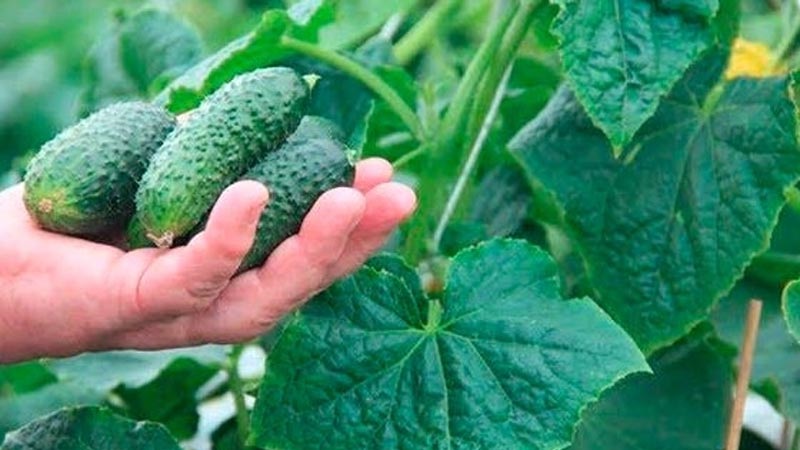
Distinctive features
In appearance, cucumbers have the same shape.... On their surface are characteristic tubercles with small spines. The fruits of the plant have an excellent presentation.
Composition, properties, benefits, calories
Cucumber is a great thirst quencher. This vegetable contains about 90% structured water... The remaining 10% contains useful minerals and vitamins: A, B1, B2, C, E, PP, H. Cucumber also contains:
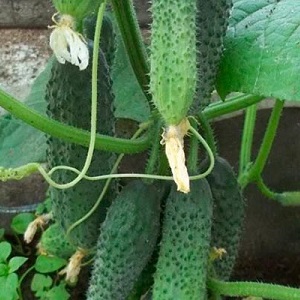 calcium;
calcium;- starch;
- fructose;
- glucose;
- phosphorus;
- carotene;
- sodium;
- potassium;
- iodine;
- magnesium.
In addition, the vegetable contains folic, caffeic and ascorbic acids.
Calorie content per 100 g of product - 15 kcal:
- proteins - 08;
- fats - 0.1;
- carbohydrates - 3.0.
Specifications
The Shosha hybrid has a female flowering type. The plant is pollinated on its own, which makes it easier to grow crops in greenhouse conditions. The shape of the flower is in the form of a crown, the color is bright yellow. One knot produces up to four fruits. The foliage is green and medium in size.
Lumpy fruits are slightly pubescent, have a thin peel, without bitterness... The pulp is light green in color. The length of the vegetable is within 10 cm, the diameter is about 4 cm. One cucumber weighs 40-60 g. The fruits have small and tender seeds.
The first greens ripen within 40 days after germination... With proper care, Shosha gives 12-14 kg of yield per square meter. m.
How to grow Shosha cucumbers yourself
The Shosha hybrid is grown both by seedlings and direct sowing in the ground... The first option gives a higher yield. The culture shows itself well in greenhouse conditions. But with any method of sowing, the seeds are disinfected in a weak solution of potassium permanganate for 20-30 minutes.
Seedling method
For growing seedlings, seeds are sown in separate containers with soil in early April... Before sowing, the seed is germinated. For this, the grains are wrapped in a damp cotton cloth and moistened as they dry.
Before germination, the container with soaked seeds is kept in a warm room with a temperature of at least +25 ° C. Sprouts appear on the second or third day. After that, they start sowing.
Important! Cucumbers do not tolerate diving well. Therefore, seeds must be sown in individual containers.
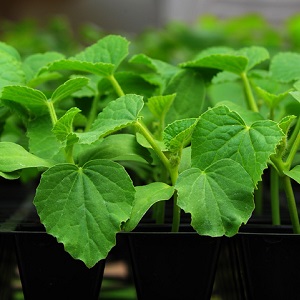 For growing seedlings, a nutritious, loose and moisture-absorbing soil is prepared... To do this, mix the following components:
For growing seedlings, a nutritious, loose and moisture-absorbing soil is prepared... To do this, mix the following components:
- clean river sand (1 part);
- sod land (2 parts);
- humus (3 parts).
After emergence, cucumbers are timely moistened with warm water... Water is used from wells, rainwater, or tap water. They are transplanted to a permanent place when the threat of frost has passed. The seedlings will be approximately 25-30 days old.
Direct sowing in the ground
Cucumber is a thermophilic culture... Its seeds begin to germinate at a temperature of at least + 15 ° C, therefore, spring sowing in open ground is carried out on beds insulated with manure.
Sowing dates - from early to mid-May, depending on the region... The grains are deepened into the soil by 1 cm. When shoots appear, leave 30-40 cm between the plants. The rest of the seedlings are transplanted if desired. To do this, the seedlings are dug out with a lump of earth and dive into prepared holes.
Important! For 1 sq. m planted no more than three plants. With this planting scheme, Shosha gives a higher yield.
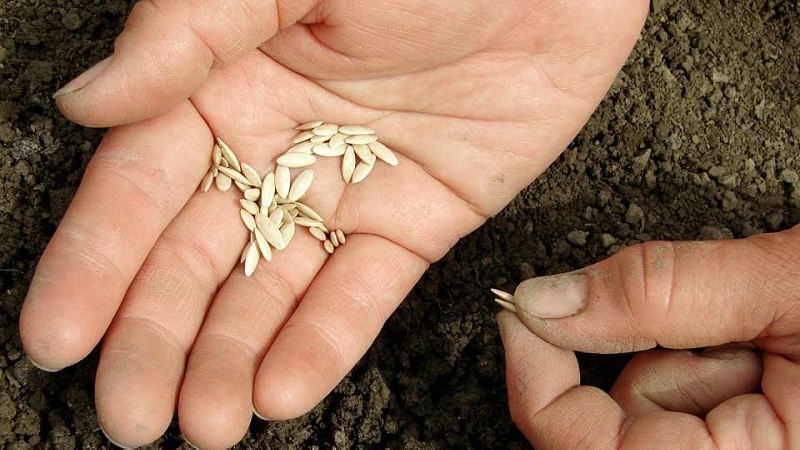
Step-by-step cultivation and care
The main care for Shosh cucumbers is to regularly moisten the soil.... If the weather is hot plants watered everyday. Cucumbers have a superficial root system, therefore, the soil under the bushes is not allowed to completely dry out. The culture is moistened with warm water.
The yield of cucumbers is negatively affected by the formation of a soil crust... This leads to oxygen starvation of plants. Therefore, after watering, they must loosen the soil. Also, the soil is mulched with a layer of humus or peat. Organic matter retains moisture well and serves as an additional source of nutrition.
Fertilizers are combined with soil moisture... Cucumbers are fed every 10-14 days with mullein infusion with the addition of ash and "Superphosphate". The first fertilizer is applied before flowering plants.
On a note. Cucumbers tend to accumulate nitrates, so nitrogen fertilizers are used in moderation.
The Shosh hybrid develops long and powerful lashes., therefore, as the culture grows, it is tied to a trellis. Supports are installed after the first full-fledged leaf appears.

To obtain high yields, the bushes form: All lateral shoots in the first three to four leaf axils are removed. If this is not done, the plants will expend their vitality to develop green mass.
As a result, the crop will begin to bear fruit with a delay and the yield will decrease significantly. Side shoots are removed when their length reaches 4-5 cm. Further growth is not allowed. The longer the stepchildren are, the worse the culture tolerates their removal.
Features of cultivation and possible difficulties
The site for planting cucumbers is chosen in a place where there are no drafts... To protect the plants from gusts of wind, sunflower or corn are planted around the perimeter. These crops are sown in the last decade of April in two or three rows with an interval of 25 cm. Such protection grows quickly and creates a beautiful natural fence.
The soil for planting cucumbers is prepared in advance... In the southern regions, the vegetable is grown in partial shade, and for more northern regions with cool summers, a sunny site is chosen.
Diseases and pests
Shosha F1 has good resistance to diseases and pests, but due to unpredictable weather or excessive moisture, there is still a risk of crop disease.

The most common diseases of cucumbers:
- Gray rot... Dark spots appear on the stem, and gray bloom on the fruits. Sprinkle the affected areas and rub lightly with ash. Moisturizing the culture is suspended - excess watering provokes and aggravates this disease. Also in the fight against gray mold use drugs "Baylon" or "Euparen".
- Powdery mildew... White or red spots appear on the leaves and stem. The affected areas are wiped with wood ash or removed. Plants are also sprayed with mullein solution or colloidal sulfur.
- White rot... The fruits gradually become covered with white mucus and then begin to rot. In this case, the infected parts are removed or sprinkled with fluff lime. The disease appears due to excessive moisture in plants.
- Root rot appears as dark spots near the roots. The stem begins to rot, which leads to the death of the roots. The disease is provoked by severe temperature changes, frequent rains or watering.The affected areas are allowed to dry up and sprinkled with lime or ash. Plants only moisturize around the bushes. To prevent disease, the soil is disinfected with a solution of potassium permanganate.
- Mosaic... Light or dark green spots appear on the leaves, then the foliage is deformed. Often, the disease also affects the fetus. The disease enters through seeds or remnants of previous crops. For prevention, grain and soil are disinfected with potassium permanganate. Diseased plants are removed.
- Olive spot... The disease manifests itself in the form of brown spots. Reasons: watering cucumbers with cold water, drafts or frequent rains. If the disease has affected the culture, the cucumbers are not moisturized for five days and are treated with Oxyhom or Bordeaux liquid.
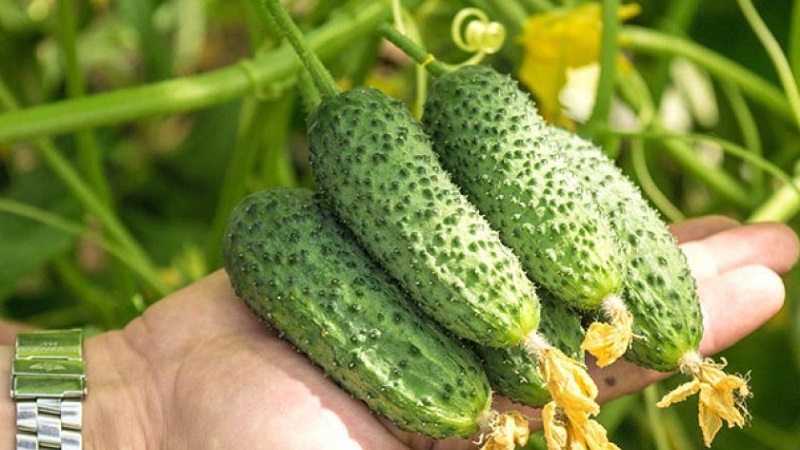
When growing cucumbers, vegetable growers often encounter pests, which greatly reduces yields. The most common insect pests:
- Spider mite... With its appearance, the foliage is covered with small white spots and a thin cobweb. The size of the pest is about 0.5 mm. These insects are dealt with with Fitoverm or Aktofit biological products.
- Whitefly... This is a small white midge that harms cucumbers. To get rid of weeds, weeds are regularly removed, the foliage is sprayed and washed with water, or the biological product "Boverin" is used.
- Melon aphid... Insects affect foliage, ovaries and flowers. The bushes begin to dry and the leaves begin to curl. The pest hibernates in the remains of vegetation. Aphids are destroyed with the biological product "Verticillin".
Harvesting and application of the crop
When the fruits reach the desired size and weight, they are carefully removed... Do not overexpose the zelents on the bushes, as this will slow down the development of new cucumbers and weaken the plants. During the period of mass fruiting, the crop is harvested every other day, especially if the hybrid grows on ridges in the spread.
Shosha cucumbers are mainly used for making fresh salads... Small greens are great for pickling and home preservation.
Advantages and disadvantages
Gardeners love the Shosha F1 cucumber for its many positive qualities. Hybrid benefits:
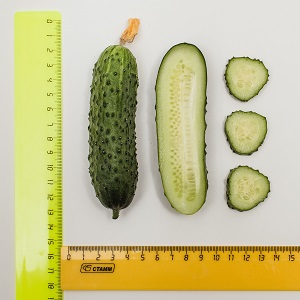 gives an early harvest;
gives an early harvest;- has strong immunity;
- fruiting occurs for a long time;
- planting and leaving does not require much effort;
- high yield (from 1 sq. m. up to 12-14 kg of greens are harvested);
- grows well both in the greenhouse and in the open field, and even in small shades;
- the versatility of the fruit;
- excellent taste;
- good presentation;
- transportability.
The hybrid has few disadvantages... These include:
- seeds for further crops are not harvested from Shosha F1 cucumbers, since this is a hybrid, not a variety;
- exactingness to the garter;
- high cost of seeds.
Shosha has more positive qualities than disadvantages, which is why many summer residents prefer this particular hybrid.
Reviews
Gardeners who have already grown Shosh cucumbers, speak about them mainly from the positive side... This vegetable is cultivated in most regions of the country. Here are the reviews of some summer residents.
 Ekaterina, Moscow region: “In mid-April, I sowed Shoshi seeds in open ground, and by the end of May, cucumbers began to appear. Seed germination is excellent, many ovaries are formed. The gherkins taste great, the rind is hard and crispy. Zelentsy have a great look, they are beautiful, as in the photo, one to one. I use these cucumbers for pickling and preserving, they look very appetizing in a jar ".
Ekaterina, Moscow region: “In mid-April, I sowed Shoshi seeds in open ground, and by the end of May, cucumbers began to appear. Seed germination is excellent, many ovaries are formed. The gherkins taste great, the rind is hard and crispy. Zelentsy have a great look, they are beautiful, as in the photo, one to one. I use these cucumbers for pickling and preserving, they look very appetizing in a jar ".
Natalia, Mtsensk: “I started working on the garden recently. I have never grown cucumbers before. The neighbors advised Shoshu. I chose the seedling method for the hybrid. It was transplanted to a permanent place in open ground in May. Cucumber bushes grew almost two meters high. She did not devote much time to plants, only watered and weeded as needed. I fertilized it twice with mullein infusion. A lot of vegetables were produced. Delicious cucumbers were eaten fresh and used for processing.I will plant even more next time. Shosha's hybrid is worthy of attention ".
Valentina, Rostov-on-Don: “Last year I bought seeds of F1 Shosha cucumbers in a gardening store. I was pleased with the harvest, I have never had so many vegetables from a hybrid culture. I grew both our hybrids and the Dutch ones, but Shosha outstripped them all on all counts. It is easy to care for the plantings. Small, smooth and crunchy cucumbers have a sweet taste. There are many tubercles and spines, but they are not prickly. The children plucked the fruits directly from the bushes, washed them and ate them immediately. In general, my family and I really liked Shosha cucumber. ".
Conclusion
Shosha cucumber is a popular early hybrid that is successfully grown both in the greenhouse and in the open field. The cultivation technology of Shoshi is no different from the agricultural technology of other cucumbers.
Experienced summer residents prefer this hybrid for its high stable yield and good crop resistance to diseases. Cucumbers have no bitterness and retain their aroma and freshness for a long time.